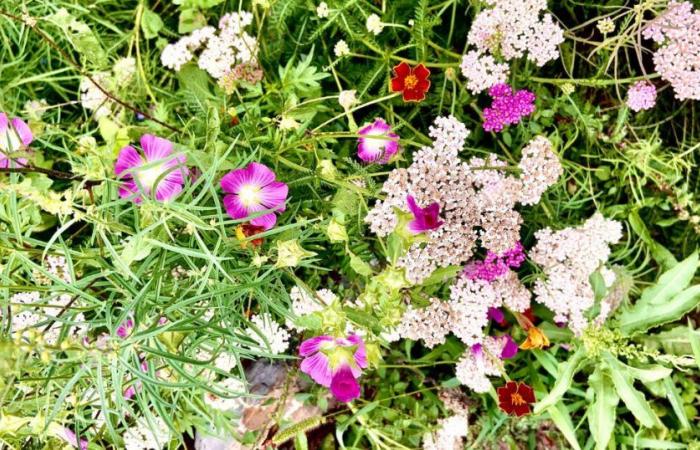I’ve been putting it off for weeks, but now the time has finally come to tell you about the flower meadow. I couldn’t do it before, simply because this year the weather has been so unstable that I’ve lost my rhythm and also control (maybe it’s a good thing?) of my Happy Garden.
For some time now I have been dedicating a small area of the sunniest and thirstiest terraces to the cultivation of annual flowers, those that are beautiful to look at (on the ground but also in the rustic bouquets that I prepare for the table), easy to grow (first-sowing proof, I assure you!) and often good to eat (yes, I admit it, eating flowers is becoming an obsession).
This piece of rainbow landscape includes dozens of different species and varieties, with some predominating over others depending on the year and the climatic conditions. It takes on shades worthy of the Pantone color range; it rises with variable heights and densities based on the bearing of each individual plant… but above all it is a place of great biodiversity, both animal and plant.
I specify both – animal and plant – because if you want to have a garden (or even just a vase on the windowsill) in full harmony with nature you can only consider them as a unicum. Without some plants a certain type of wildlife would not arrive, but without the latter a large part of the plant diversity and richness would be at risk. The system works if it is complete and shared.
Flowery meadow: let’s understand it together
But what does it mean to grow a flowery meadow that promotes and attracts biodiversity? Because it seems obvious, but it is not, at least not for everyone. Growing a flowery meadow means learning the art of knowing how to wait, gradually accustoming your eyes to enjoy the slightly disheveled and soft beauty of nature. It means giving up mowing to allow not only complete flowering, but also the natural drying of the seeds on the plant, to guarantee future generations.
It also means welcoming the wild herbs that will infiltrate our crops, trying to decode their beauty made of strength, resilience, adaptability. But also not to bomb (read: treat with non-natural products) the plants to have bigger, showier, more performing flowers. Because by doing so, perhaps our sight will be satisfied, but not our hearing, which will search in vain for that buzzing of pollinators that have escaped from the poison, if not died because of it. Cultivating a flowery meadow means above all giving up to have, but also learning to (re)connect with nature.
Have I piqued your curiosity? Then follow me in the next chapter to understand how to do it. Even in the city. Even on the terrace. Even on a balcony or a windowsill. Because you can sow anywhere.
Flower meadow: how to do it on the ground but also in a pot
Password: sow. Try everywhere, in any situation and season. You will make a lot of mistakes but sooner or later you will find “your” seed, the one you have germinated. There are plants that live well in humid, marshy soils. Others that only flower in dry conditions, wedged between dry stone walls. Others in the cool of spring, some instead when the snow melts or under the scorching sun of the Mediterranean summer. The first piece of advice is therefore to choose a mix of species that are right for your territory and for the time of year, so you will not be disappointed.
Before sowing, prepare the soil by hoeing the surface (not too deeply so as not to disturb the fauna that lives underground). Then proceed according to your taste: do you want a messy mix that imitates nature? Mix the seeds of the species you have chosen and scatter them.
Do you want to try to give an order of color, heights, blooms? Then plan how to proceed, perhaps helping yourself with a rough drawing or tracing directly on the ground.
If you are a beginner and/or have little space, I recommend sowing in small pots. This way you will better control germination and then you can transplant into the ground or into larger containers once the seedlings have rooted well, avoiding “holes”.
The seed needs care and kindness
Remember that the germinating seed is a very fragile living being, because it is passing from a dormant phase to an active/vegetative one. So stay close to it, observe it, help it with its needs, especially water. In short, cuddle it as you would with any newborn animal or plant. Full soil or pot? As always, it depends. Here are the pros and cons. In the ground, once rooted, they will do everything or almost everything by themselves and will also self-seed for the following year. However, it is more difficult to control the final look of the whole, so you need to have a good knowledge of the development and flowering period and life of each individual species in the mix.
On the contrary, making a potted garden (do you know what it is? If you don’t remember, click here) requires more assistance, at least for irrigation, but it allows you to plant many single-species pots and then create the perfect mix by composing them together, possibly replacing early flowering with seasonal ones.
Green Pill: English Cottage Style Mediterranean Style
To have borders that are always in bloom, which in style and exuberance recall the English ones, sow different species but with similar needs, so that they can be mixed together, creating that fake-disheveled and romantic effect of English gardens.
Using annual plants with staggered flowering, you can have multi-colored corollas from late spring to early autumn (give or take a month depending on where you are).
Curiosity 1: a flower on the plate
Many of the easy, beautiful and happy annual flowers I have told you about are also edible in one or more parts of the plant (corollas, seeds, leaves, fruits, stems). If you want to try marigold, borage, nasturtium, dandelion, daisy, fennel, rocket, cornflower, nigella, sunflower, mallow (…) remember to use natural fertilizers (or better yet, a soil rich in organic matter, so as to avoid any treatment other than simple irrigation).
Curiosity 2: Swingers for Passion
If you are interested in the world of seed and knowledge exchange, I suggest you find out if there are themed events in your area. Every year, at the end of January, I go to the Mandillo dei Semi in the Ligurian hinterland and come back with a basket full of lots of seeds, cuttings, scions and life stories to tell.
There are also dedicated groups on Facebook, thanks to which people can send each other the desired species, exchanging them or even as gifts, paying only for shipping. Finally, I would recommend the A.Di.PA association (https://www.adipa.it), present throughout the country, with offices and ad hoc events in all regions. If you happen to live in Liguria you are even luckier: Anna Maria Vitali, the area president, is very passionate and with her husband organizes many moments of information and exchange.






